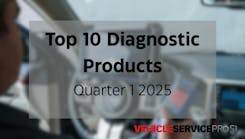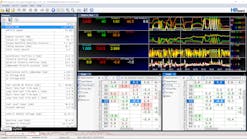Using the 9 modes of Global OBDII in diagnostics
Editor's note: This article was originally published March 1, 2009. Some of the information may no longer be relevant, so please use it at your discretion.
Each shop I've ever worked in, from dealer to independent, has offered Check Engine Light diagnosis as a part of its basic menu of services. Most of these shops catered to all car lines, but could only afford to stock a single, aftermarket scan tool for technicians to use. These scan tools may have had some "enhanced" ability — that is, they may have had some access to manufacturer specific information, but thanks to on-board diagnostics (OBDII) standards, they all had access to the same information regardless of the nameplate on the car, using the Global OBDII selection on the tool's menu.
OBDII Basics
The Engine Control Module (ECM) on an OBDII-compliant vehicle has one primary function: to keep vehicle emissions in line. It does so by controlling and monitoring any system that will have an impact on emissions. Every powertrain-related Diagnostic Trouble Code (DTC) is related to emissions in some way.
OBDII also corrected some of the problems posed by OBDI. Code format was standardized and generic code definitions established. The Data Link Connector (DLC) also was standardized. The ECM's testing ability was enhanced from just basic circuit integrity tests, adding functional and rationality testing of emissions-related systems and components.
Diagnostic information was made more standard, with common PIDs (Parameter Identification) among manufacturers instead of a smorgasbord of terms for us to learn. Other modes were added to aid technicians not privy to OE level information or scan tools in diagnosing faults discovered by the ECM. Due to the efforts of organizations like the National Automotive Service Task Force (NASTF), OE information once considered proprietary is now available to anyone. This was not the case at the time OBDII was first implemented.
All in all, there currently are nine modes available when using the Global OBDII (not to be confused with Generic OBDII) function of your aftermarket scan tool. The majority of Check Engine Light complaints I solve on a daily basis are diagnosed and repaired using just the information these nine modes can provide.
Mode 1: Monitor status and current data
Mode 1 is where you will find the status of the onboard monitors. Each monitor is associated with a system or component on the car that can impact the emissions it produces. Monitors are classified as either continuous or non-continuous. The continuous monitors are the comprehensive component monitor, the misfire monitor, and the fuel monitor. All the others are non-continuous.
Each monitor contains a test or series of tests the ECM uses to gauge the operational health of that system or component. The monitor status screen simply tells us whether all of the tests contained within that monitor have run to completion. When checked, they should all read, "Ready or complete". If the vehicle you are testing does not use a given monitor, then the message will read, "Not supported or not available".
Any monitor that reads Not Ready or Not Complete indicates a few things. Either the codes have been cleared with a scan tool, causing the monitors to reset, or battery power has been lost to the ECM. This can be a diagnostic aid. If power was lost due to a wiring fault or ailing battery, the ECM is constantly "rebooting" and this can cause some drivability issues.
In addition to the status of the monitors, Mode 1 is home to Current Data, also called Live Data. This is the screen showing the PID information live. Unlike some OE enhanced PIDS, however, Global OBDII PIDs are ACTUAL data. A good example is the Engine Coolant Temperature (ECT) PID. Because this PID is related to fuel control, some OEMs will substitute a data value if the true ECT reading is suspect, and that is the number you will see in enhanced mode. In Global mode, though, you will see the true ECT reading, whatever it may be.
Mode 2: Freeze frame
Freeze Frame is a record of the available data PIDs stored by the ECM at the same time it matures a DTC. This can be important information for diagnosis. It helps you recreate the conditions present at the time the trouble code was matured.
This is especially valuable when diagnosing codes related to the continuous monitors, because they can be recorded at any load/rpm combination. Freeze Frame stored for codes related to the non-continuous monitors is usually just a reflection of the conditions required by the ECM to run the applicable test.
Mode 3: Stored DTC's
Mode 3 is where you will find a list of any DTCs that have matured and caused the ECM to command the Malfunction Indicator Lamp (MIL) on. These can be the first fault of a "1-trip" code or the second consecutive fault of a "2-trip" code.
Even if a code has matured, the ECM keeps testing. If the test(s) that once failed now pass for three consecutive tries, the ECM will turn off the MIL. The code, however, will continue to be stored in Mode 3.
After a specified number of warm-up cycles with no recurrence, the code will be erased from memory. This often comes into play when a customer sets an appointment for a Check Engine diagnosis, but by the time he or she arrives, the MIL is off. Look anyway, because the culprit may still be in there somewhere.
Mode 4: Clear codes
Once you have completed the repairs and are ready to verify that repair, use Mode 4 to clear the code(s) from memory. But don't do it until you are ready to verify the fix. Clearing the codes will also reset the monitors and erase any existing test results they contain.
Mode 5: Oxygen sensor monitor test results
Mode 5 contains the tests and their results the ECM used to verify the proper operation of the oxygen sensors.
This can help when faced with certain diagnostic challenges, like chasing down the cause of a catalytic converter efficiency code.
Because these tests usually use information from the oxygen sensors, a faulty sensor will affect the results and may be the root cause of the DTC. Checking Mode 5 test results, if available, can help verify the health of the oxygen sensors. If Mode 5 isn't available for the vehicle you are testing, the answer will lie in the next mode on the list.
Mode 6: Non-continuous Monitor Test Results
Mode 6 is unique in that it lists the individual tests and their results for every non-continuous monitor. In the past, this information was hidden; that is, the data displayed had to be translated and converted before a tech had real information he or she could use. Today, though, most aftermarket service information systems list the test identifications and descriptions, making Mode 6 friendlier and more valuable.
Early Ford Mode 6 also included misfire monitor test results, even though this monitor is classified as continuous.
All vehicles using Controller Area Network (CAN) protocol have the misfire monitor results as well. In addition, CAN vehicles have improved Mode 6 with data screens already translated and converted into real data.
Mode 7: Continuous monitor test results
Many aftermarket scan tools list Mode 7 as Pending Codes. Here is where you will find record of any 2-trip code related to the continuous monitors that the ECM has failed once already. Mode 7 can be used to test your repairs of these codes by clearing the ECM, test-driving the car under the same conditions recorded in the original Freeze Frame and checking to see if the code reappears here. Some later-year OBDII vehicles, and all CAN vehicles, will record the first fault of non-continuous monitor related codes in Mode 7.
Mode 8: Request control of onboard systems
Currently, only the EVAP system is available here, and then only on some vehicles. Mode 8, if available, will seal the EVAP system by closing the canister vent valve, allowing you to then vacuum or pressure test the system for leaks.
Mode 9: Vehicle information
Mode 9 contains the Vehicle Identification Number (VIN), and the ECM's calibration information. Because many drivability issues are related to programming, this information can help you determine whether or not the module requires a reflash. And I have been burned once by missing a mismatched VIN, due to a junkyard ECM being installed in the car. Most aftermarket scan tools require all sorts of information be input before being able to connect in enhanced modes. Global OBDII hook-up is generally faster, with no such need.
And now that you know all nine modes, and what they have to offer, you'll be able to diagnose even more powertrain related codes using it.


